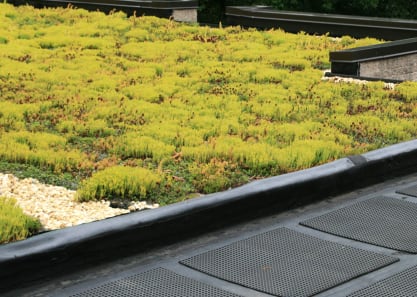
How to avoid common living roof engineering pitfalls
- Read time: 3 minutes
- Date: 12 Jun 2023
- Living Roof
Living roofs are increasing in popularity and the market is predicted to continue growing. This offers a fantastic opportunity for roofing contractors, but there are an increasing number of cases where living roofs are not performing as well today as when they were first installed.
If the wrong materials and components are used or the living roof is not installed and maintained correctly, it will not perform well over time. If the right conditions are not provided, the foliage dies, and you receive complaints. In a worst-case scenario, this will lead to total living roof collapse.
It’s therefore vital to understand the basic principles of a living roof to ensure its longevity.
What are the most common living roof engineering pitfalls?
Inadequate drainage caused by blockages
Impact: Drain blockages cause ponding, drowning plant life and increasing roof load.
Solution: Drains need to be protected and inspected regularly.

Pitched roof soil slippage
Impact: Soil gradually slips down a pitched roof over time, compromising appearance and drainage.
Solution: Secure edges and anti-slump products prevent slippage.

Rust causing metal components to disintegrate
Impact: Components need replacing, resulting in large maintenance bills.
Solution: Living roof components should be made from aluminium or stainless steel rather than coated steel which has limited corrosion resistance.

Wind scour causing stone erosion
Impact: Loose stones can fall on passers-by or damage surrounding property.
Solution: An adhesive can be used to bond the stones together to allow drainage but prevent erosion.

Compromised fire breaks
Impact: The roof no longer complies with fire regulations.
Solution: Metal edging acts as a physical barrier between the plant matter and the gravel fire break.

Lack of access
Impact: Maintenance becomes irregular, a primary cause of plant failure and drainage issues.
Solution: Provide safe roof access and collective protection for maintenance personnel.

Leaks caused by damaged waterproof membranes
Impact: Replacement of the membrane is expensive and may mean removing all plant life.
Solution: Avoid working practices which may breach the membrane.






